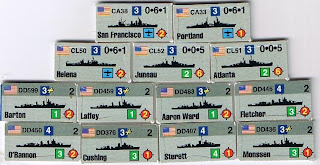It looked like a tough job for the Americans, so I gamely volunteered to take their side. After all, there were two posthumous Medals of Honor awarded to the two American admirals killed in the battle.
One thing became apparent during the setup was that the given setup was incorrect. As shown by Morison the American force was in one long column at the outset of the fighting, so it appears that the USN group listed as setting up in C5 is supposed to be in D5, so that's where we put them.

The US starts with the initiative, so the Japanese had to move first. The Battleship group cut to starboard while the Japanese all-destroyer group steamed straight ahead. The Americans took advantage of this opportunity to concentrate against a portion of the Japanese fleet and moved both groups in front of the Japanese force.
The exchange of gunfire was pretty even, with both sides taking an assortment of gun and hull hits, but ominously no torpedo mounts were knocked out. The USN elected not to fire torpedoes at this time, hoping to save them against the battleships, but the Japanese gleefully launched a salvo of 17 factors of Long Lances at the US force -- after all the Japanese had reloads! They also had luck, as each of the three leading US cruisers was hit by two torpedoes. Surviving even one Long Lance is tough, but with 2 it's almost impossible and all three US cruisers -- Portland, San Francisco and Atlanta -- went down. The two US admirals were likely casualties -- but unlikely Medal of Honor recipients under the circumstances.
On the next impulse the Japanese battleships turned about to try to close on the US force while the Japanese destroyer force pulled back o reload torpedoes. The US fleet took advantage of its initiative to countermarch back towards the Japanese battleship force. The Helena-led force crossed the T of the battleships while the destroyers that had survived cruiser massacre faced the Japanese force broadside. Their prospects were grim because they were also within range of the Japanese destroyer force.

The Japanese force at the First Battle of Guadalcanal
Bombardment Force (Abe)
The gunbattle was again pretty even, as the US was able to do damage to most of the enemy ships fired at, and took some in return. Several US destroyers went down simply because of the volume of fire coming their way. Notably the USS Laffey survived a 14-inch hit that was a dud!Bombardment Force (Abe)
This time the Japanese force fired 22 factors of Long Lances at the US force. This time the Japanese luck wasn't quite so good, as the Helena was missed, as were a couple of destroyers. But three torpedoes clobbered the USS Juneau and the USS Fletcher and USS Monssen each took one. None of these were survivable hits.
The US force managed to get some measure of revenge at this point, firing a total of 7 torpedo factors from the surviving ships at the Hiei. (US torpedo factors are quartered in scenarios set before September 1943). Three hit the Japanese battleship and all three were good solid hits that just managed to sink the Japanese battleship (which had taken a couple of hull hits from the Helena's guns earlier.)
The cheers on the US ships were short-lived. Despite mentioning that the Japanese could retire with honor and victory assured, my stepson was having none of that, and announced his intention to run down the survivors without mercy. Which he did. And it didn't take long, either, just two more impulses as a matter of fact. While the US ships were able to score a few more hits, none were fatal, whereas the Japanese force just blasted away. The last US ship to sink under the waves was the USS Laffey.
The final score was 205 points for the Japanese (US force wiped out). The US got 84 points for sinking the Hiei. Kirishima was untouched. The US also picked up 5 victory points for hull hits on surviving Japanese ships (Nagara, Yukikaze, Asagumo and Inadzuma), for a total of 89 points.
The scenario didn't do a good job of recreating the historical battle. The US gunnery was nowhere as effective as it was historically, with most of the significant damage coming from torpedoes, which were ineffective in history. Likewise the Japanese torpedoes were far too deadly, sinking four of the US cruisers and a couple of destroyers. Japanese gunnery was also overwhelming. This illustrates the limitations of the tactical combat system in the Avalanche Press Second World War at Sea series, which seems overly deadly and allows too much efficiency in allocating fires. The actual battle -- while still the deadliest rumble during the war -- was far more confused and resulted in a much lower toll. Most ships had trouble finding targets, friendly fire was a problem and ships often masked the fire of friendly ships. The tactical system works better for daylight battles where both sides maintain command control, but is too simple to deal with a confused night melee like Guadalcanal I.

Mr. Owen,
ReplyDeleteJust a quick note to say how much I enjoy reading your blog.
As a old grognard, it brings me back to that happy period when I had the free time in which to play and opponents to play against.
Thank you again.
Bill Cameron
Dover, NH